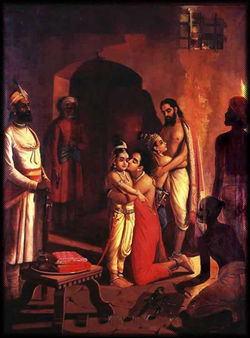Raja Ravi Varma was a celebrated Indian painter and artist. He is considered among the greatest painters in the history of Indian art for a number of aesthetic and broader social reasons. Firstly, his works are held to be among the best examples of the fusion of European techniques with a purely Indian sensibility. While continuing the tradition and aesthetics of Indian art, his paintings employed the latest European academic art techniques of the day. Secondly, he was notable for making affordable lithographs of his paintings available to the public, which greatly enhanced his reach and influence as a painter and public figure. Indeed, his lithographs increased the involvement of common people with fine arts and defined artistic tastes among common people for several decades.
Contents
About Raja Ravi Verma
Raja Ravi Varma was born on 29th April 1848, in Kilimanoor, a small town of Kerala. He is known for his amazing paintings, which revolve mainly around the great epics of Mahabharata and Ramayana. Raja Ravi Varma is one of the few painters who have managed to accomplish a beautiful unison of the Indian traditions with the techniques of European academic art. He left for the holy abode on 2nd October 1906, leaving behind his legacy of amazing paintings. Raja Ravi Verma's paintings of beautiful sari clad women have also received recognition in the west.[1]
Professional Aspects
Raja Ravi Varma received systematic training, first in the traditional art of Thanjavoor and then, in the European art. He is credited with providing the critical link between Thanjavoor School and Western academic realism. His paintings can be classified into the following three categories-
- Portraits
- Portrait-based Compositions
- Theatrical Compositions, based on myths and legends
It is the third category of paintings for which Raja Ravi Varma is the most renowned. He was continuously traveling through the length and breadth of India, in order to find subjects for his paintings. His love for the South Indian women is depicted through his works. In many of his paintings, he has modeled Hindu Goddesses on the women living in the southern parts of India. The most popular as well as impressive paintings of Raja Ravi Verma include the ones depicting episodes from the story of Dushyanta and Shakuntala and that of Nala and Damayanti.[1]





